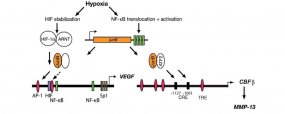JunB: A critical regulator of inflammatory processes and angiogenesis
JunB is a subunit of the AP-1 transcription factor complex that mediates gene regulation in response to a plethora of extracellular stimuli. In order to dissect the individual functions of JunB in vivo, we have generated in the past complete and conditional loss of function mutations in mice. Our studies and work of others showed that critically balanced JunB levels are essential for normal physiology as loss or over-expression of JunB could be associated with numerous impaired physiological functions but also disease states. One major scientific goal of our laboratory was and still is to identify novel JunB target genes implicated in developmental and disease-associated cellular processes. Within the period under report, we focused on the role of JunB in skin homeostasis and differentiation, in immune functions and in angiogenesis and angiogenesis-associated pathologies.
JunB functions in immune cells
A cell type that is frequently found at sites of potential infection and inflammation, at the vicinity of blood vessels and the margins of diverse tumours are mast cells, effector cells of IgE-mediated immune responses. We could demonstrate that JunB is required for proper mast cell degranulation since JunB controls genes like SWAP-70, VAMP-8 and SYT-1 that are essential for Fc epsilon RI-triggered exocytosis. Moreover, JunB-deficient bone marrow mast cells display an altered cytokine expression profile in response to IgE stimulation that affects the cross-talk of mast cells with endothelial cells. Yet, JunB not only influences immune cells via its regulatory impact on chemokine/cytokine levels, its absence alerts also immune cells to tumours and stressed cells. This is achieved via an upregulation of RAE-1 epsilon expression, the ligand of the activating receptor NKG2D playing an important role in the NK, gammadelta+, and CD8+ T cell-mediated immune response to tumours.
JunB functions in angiogenesis

Figure 1: Model for JunB-dependent transcriptional induction of VEGF and CBF beta in response to hypoxia
© dkfz.de
Complete loss but also endothelial-cell specific ablation of JunB resulted in very similar angiogenic defects with subsequent embryonic lethality suggesting that JunB has a critical role in angiogenic processes. We could demonstrate that junB is a target gene of hypoxia-induced signalling, a fact that we could also confirm for tissue biopsies of preeclamptic human placentas. Preeclampsia is a multisystemic pregnancy-associated vascular disease being still a principal cause of fetal and maternal morbidity and mortality. Gene expression profiling revealed upregulation of junB that is due to the hypoxic state of preeclamptic placentas but also identified a novel differentially expressed transcript, the soluble form of the disintegrin metalloprotease ADAM-12, a putative AP-1 target gene. ADAM-12 could serve as an early biomarker for preeclampsia that may be of predictive and/or functional significance as we also found elevated protein levels in the serum of preeclamptic pregnant women.
Analyses of different JunB-deficient murine cell types revealed that junB is a target gene of hypoxia-induced signalling via NF-kappaB. Loss of JunB results in severely impaired expression of VEGF, a key regulator of angiogenesis. Despite the presence and stabilization of the major hypoxia induced transcription factor HIF, VEGF expression and induction in response to hypoxia as well as hypoglycemia requires the presence of JunB. In support of these findings, tumour angiogenesis was impaired in junB-/- teratocarcinomas due to insufficient levels of paracrine-acting VEGF and to the subsequent inability to efficiently recruit host-derived vessels. Furthermore, we could show that cell-autonomous endothelial functions of JunB are required for proper endothelial morphogenesis both in vivo in mouse embryos with endothelial-specific ablation of JunB and in in vitro angiogenesis models. We identified a novel regulatory axis required for EC morphogenesis that involves the novel direct JunB target gene core-binding factor beta (CBFbeta) and its target MMP-13. CBF beta forms together with the Runx proteins the heterodimeric core-binding transcription complex CBF. As a third JunB-dependent angiogenic target, we could identify Heme oxygenase-1, which catalyzes breakdown of the prooxidant heme.
The identification of these novel JunB target genes but also the understanding of their regulation mode will help to define but also predict events occurring in vivo in disease-associated processes like in psoriasis and cancer and may help to develop therapeutic approaches.

© dkfz.de
Figure 2: Angiogenic phenotypes seen in JunB-deficient embryos and in vivo or ex vivo cell systems affecting embryogenesis, tumour angiogenesis and endothelial cell sprouting. For experimental details see Licht et al., 2006; Schmidt et al., 2007.
